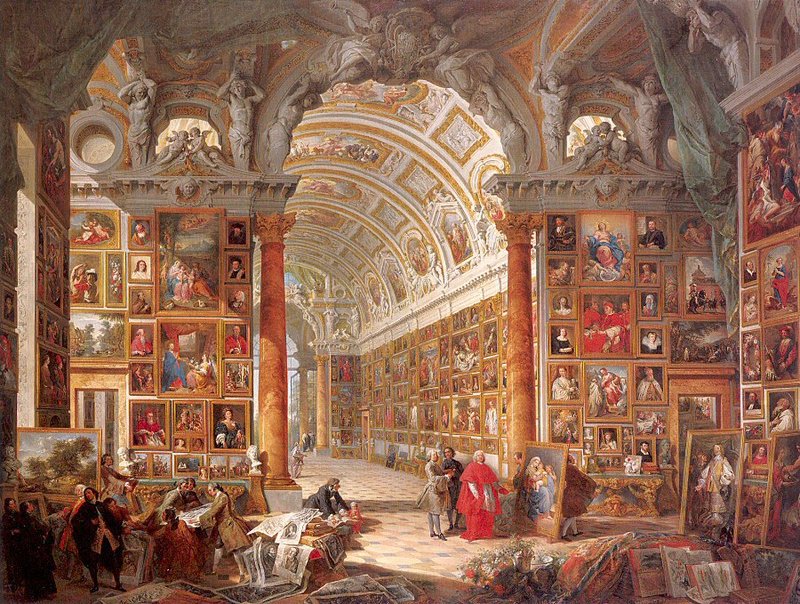Social Interactions in 18th-Century Rome

Giovanni Paolo Panini, Interior of a Picture Gallery with the Collection of Cardinal Silvio Valenti Gonzaga, 1749, oil on canvas (Wadsworth Atheneum, Hartford).
Due to the clement climate, much of Roman life revolved around the countless piazzas in the city, many of which housed cafes, businesses, and even art galleries. Piazzas were not only frequented as informal rendezvous points for conversation and casual exercise for both Romans and foreign visitors, but also contained more practical uses, as they had fountains that held potable water for personal consumption as well as sites dedicated to public executions and whippings.1 Official events of the state, like the annual festival which featured fireworks, street performances, and parades, and the famous Carnival, a week-long celebration leading up to the Lenten season of penance and abstinence, were also celebrated in piazzas. More often than not, the city squares were crowded with both Romans and foreign visitors alike.2
Besides visiting the ruins of Ancient Roman monuments, foreign visitors had the opportunity to interact with Romans in the numerous collections of art and sculpture that were accessible to wealthy travelers and sometimes the general public. Such collections were often displayed in the homes of the Roman aristocracy, the most elaborate of which were dubbed “urban palaces” due to their sheer size and decor.3 Foreigners were invited to attend conversazioni hosted by the Roman bourgeois and aristocrats in their palaces, where the travelers were given the opportunity not only to party with the Romans, but also to mingle with and observe the Roman nobility and Italian customs. Despite all the elegance and excitement surrounding the conversazioni, these evening conversations were often crowded with many visitors and were often overwhelming, not unlike the actual displays of painting and sculptures.4 As exemplified in the 1749 Giovanni Paolo Panini (1691-1765) painting, Interior of a Picture Gallery with the Collection of Cardinal Silvio Valenti Gonzaga, the displays of art were exhaustive; paintings and frescos covered the walls of palaces from the floor to the ceiling. Often without written commentary, the collections of art themselves were intended for the consumption of an already well-versed audience. The massive rooms in which the collections were displayed were meant for daytime use only, as most of them lacked basic amenities for visiting guests.5
Interactions with foreigners were not limited to just the aristocrats; the numerous servants and employees working in the houses of leading cardinals and popes had no reservations in asking wealthy visitors for tips upon their visit to aristocratic residences or even engaging in petty fraud against their employers, which was commonplace and expected as compensation for low wages. The presence of beggars in the streets revealed the Roman attitude towards the unemployed and the poor; not only did the Romans tolerate the ubiquity of beggars, they accepted the less fortunate as a part of society while using them as a means to become more pious through donations of money and food.6
The informal, hardly regulated relationships and interactions between the poor and the aristocracy were commented on in sermons, edicts, diaries, and letters, many of which claimed that the lack of social hierarchy was causing a decline in public morality. An anonymous pamphlet sent to Pope Benedict XIII in 1724 blamed the ills of contemporary society on the popularity of conversazioni, social gatherings featuring conversation, gaming, and light refreshments, claiming that such social practices were causing people to neglect their sacred duties in favor of pleasure.7
JF
__________
1 Sir George Head, Rome: A tour of many days (London, 1849), 120.
2 Joseph J. Rishel, Edgar Peters Bowron, Houston Museum of Fine Arts, and Philadelphia Museum of Art, Art In Rome In the Eighteenth Century (London: In association with Philadelphia Museum of Art, 2000), 35.
3 Carole Paul, The Borghese Collections and the Display of Art in the Age of the Grand Tour (Aldershot: Ashgate Publishing Limited, 2008), 7.
4 Ibid., 9.
5 Ibid., 10.
6 Rishel, Bowron, Houston Museum of Fine Arts, and Philadelphia Museum of Art, Art In Rome, 33.
7 Ibid., 34.